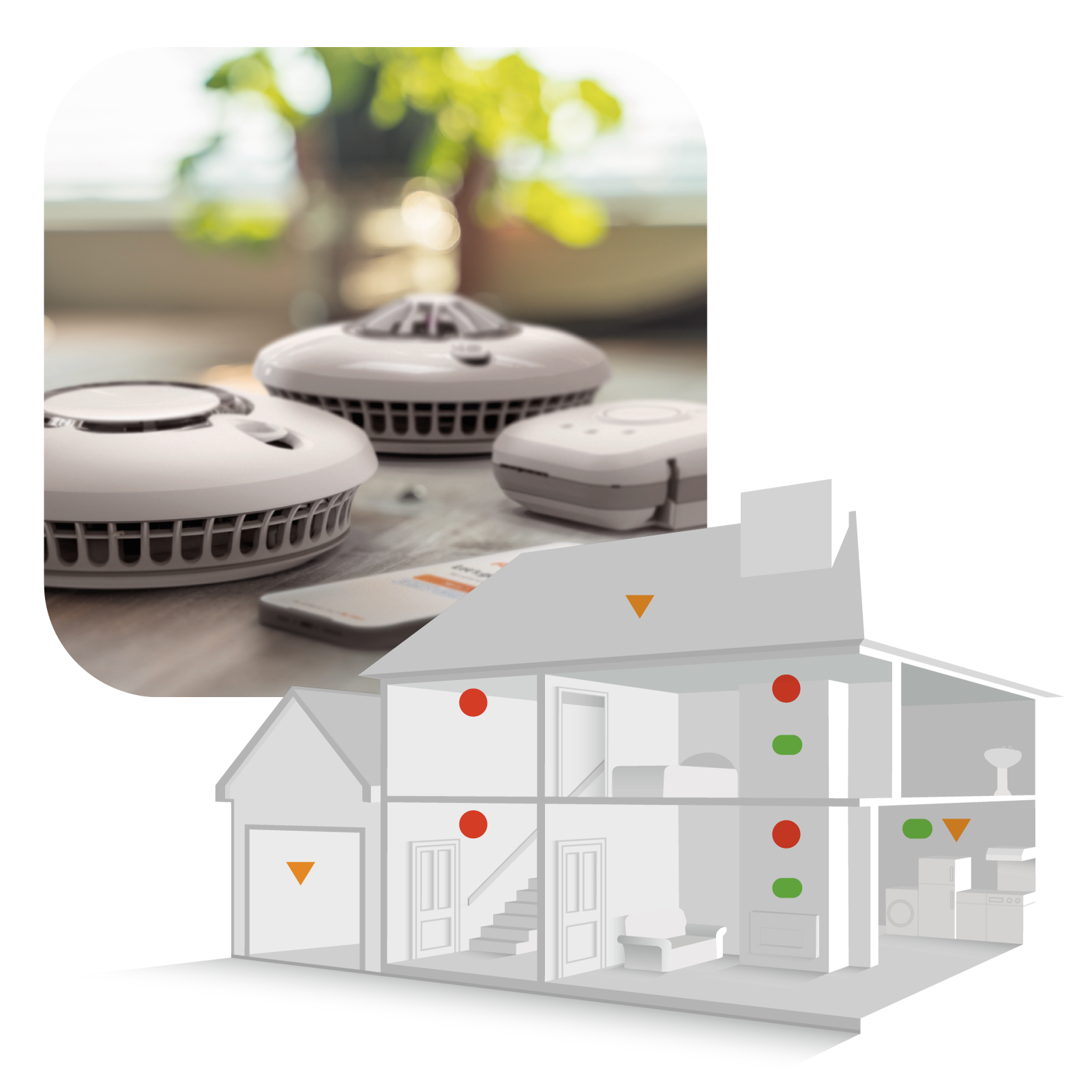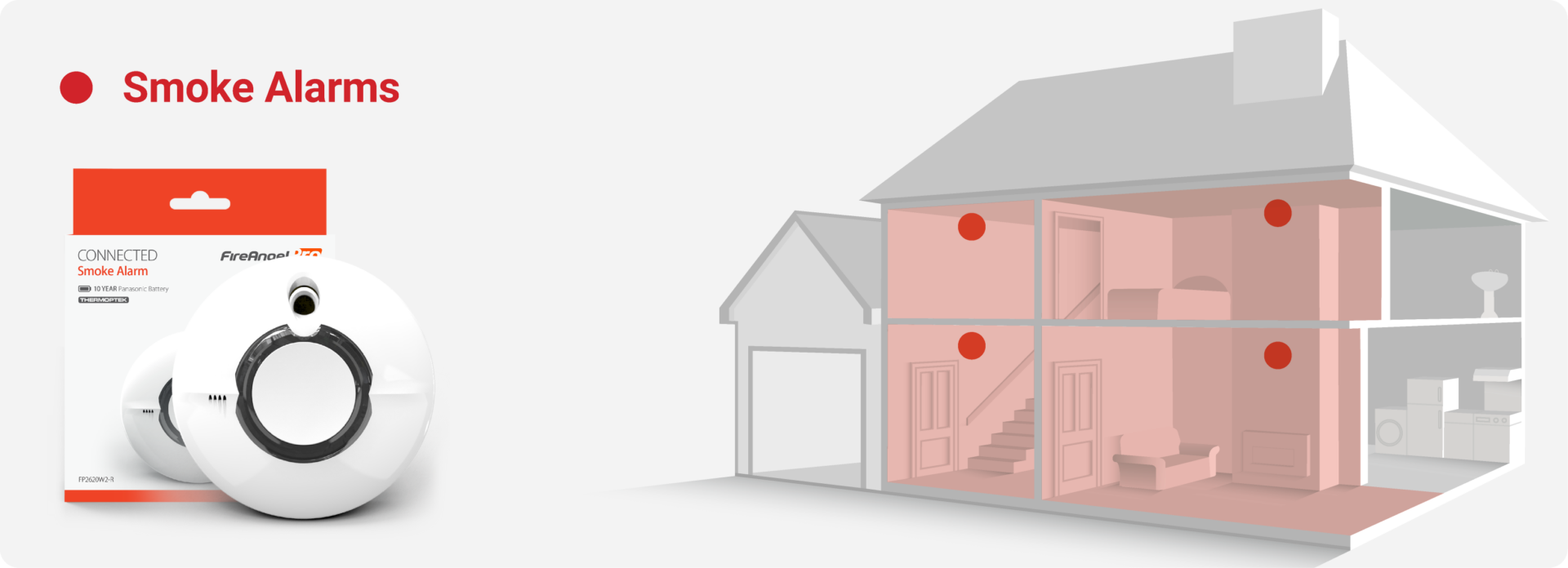Are you a
Homeowner?Are you a
Homeowner?
If installed correctly, fire and CO alarms provide an early warning to danger and will provide essential protection for your home. However, understanding what alarms to choose and where to install can be confusing.
Follow our recommendations on what smoke, heat and CO alarms need to be in your home and best practice as to where to fit.
Most British homes require a smoke alarm to be fitted in any circulation areas, such as your hallway or landing. But each nation has slightly different legal requirements as to the type of smoke alarms, (such as mains-powered or battery powered, standalone or interlinked), and how many should be installed – so make sure to check your local standards.
Look for smoke alarms that use ‘Thermoptek’ multi-sensor technology which is most effective for detecting fast-flaming and slow-burning fires compared to other alarms.
FireAngel recommend installing a working smoke alarm in all rooms of your home apart from bathrooms, kitchens, lofts and garages.
Fit your smoke alarm on the ceiling, as close to the centre of the room or hallway as possible. Try to keep at least 30cm away from the wall or any light fittings.

When nearly 50% of fires start in the kitchen, it’s vital this dangerous room is kept protected with a heat alarm. Heat alarms can also be installed in areas of high humidity, dust or fumes such as garages and loft conversions.
Look for heat alarms that use ‘Thermistek’ enhanced sensing technology that detect a rapid rise in temperature.
FireAngel recommend to install a working heat alarm in your kitchen, garage and/or loft.
Fit your alarm on the ceiling, as close to the centre of the room as possible. Try to keep at least 30cm away from the wall or any light fittings. Heat alarms should not be installed on the wall.
FireAngel are proud to support the UK Government’s Fire Kills campaign. Make sure any smoke and heat alarms you install in your home are tested regularly, we recommend on a monthly basis, and are replaced every 10 years.
You can keep your alarms in optimum condition by cleaning with the soft brush of a hoover and removing if painting the ceiling to prevent damage, just remember to replace once finished.
Carbon monoxide (CO) is a poisonous gas, invisible to the human senses, that is produced when a fuel is not burnt properly. It’s estimated 50 preventable deaths in England & Wales occur every year due to CO poisoning. You can find out more about this ‘silent killer’ here.
CO alarms are the only way to detect this poisonous gas and provide the earliest warning to allow you time to take action.
FireAngel recommend fitting an audible carbon monoxide alarm in the same room as fuel-burning appliances e.g. gas boilers, gas fires, cookers and grills. If the alarm is on the ceiling it should be at least 30cm from any wall and any light fittings.
CO alarms can be either wall or ceiling mounted and should be located between 1m and 3m from the potential source of carbon monoxide. As carbon monoxide can pass through from a neighbour’s property, it is also advised to install a CO alarm in the most used rooms of the house and any sleeping areas. In bedrooms they should be installed relatively close to the breathing zone of the occupants.
FireAngel are proud to support the national campaign Project Shout to raise awareness of the dangers of carbon monoxide poisoning. The campaign was launched in September 2015, with the help of two inspirational mums, Stacey Rodgers and Louise Aspinall. Find out more about Project Shout.
Interlinking alarms
Choosing to install alarms that can interlink with one another, either wirelessly or hardwire, ensures that when one alarm sounds, they all sound. This means you can be alerted to the first signs of danger in the home wherever you are. FireAngel’s Pro Connected range of alarms all interlink.
Mains or battery powered
Any mains-powered alarms should always be fitted by a professional electrician. If you opt for battery powered alarms, it’s recommended to look for ‘sealed-for-life’ or long-life batteries that will last the lifetime of the alarm (you should replace your smoke alarm every 10 years!).
Smart smoke and heat alarms
For the highest level of fire safety, consider installing ‘smart’ alarms for the ability to control, test and monitor devices remotely using an app without having to reach a ceiling mounted test button. With the ability to name alarms listed in your app and add multiple locations, smart alarms offer an ideal way to ensure fire protection in homes of parents, elderly neighbours or vulnerable family members. Find out more about FireAngel’s smart alarm range.
For more safety advice on keeping protected from fire and carbon monoxide at home, download our latest safety guides.
If you can't find what your looking for on our blogs and looking for further guidance and advice, our UK-based Customer Support team are on hand all week from 8:30am until 5:30pm, they can answer any further queries you may have on our products, solutions or services.